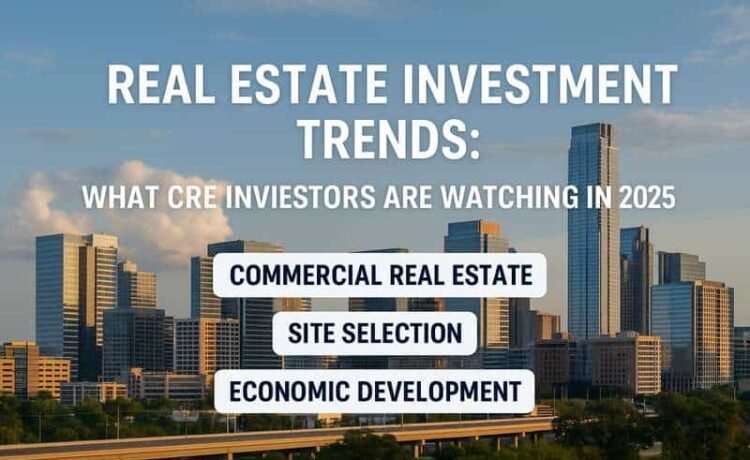

1. Migration to Mid-Sized Growth Markets
Once dominated by coastal metros like San Francisco and New York, CRE investment flows are increasingly favoring “rising star” metros. Cities such as Raleigh, NC, Boise, ID, and Columbus, OH are gaining attention due to talent migration, lower living costs, and robust public-private partnerships.
According to a Brookings Institution report, these mid-sized cities are showing the highest post-pandemic economic momentum and job growth in the nation. States like Texas, Florida, and Tennessee continue to lead in net domestic migration (U.S. Census Bureau)—a major draw for multifamily, industrial, and healthcare real estate developers.
2. Site Selection Now Hinges on Data, Power, and Talent
Today’s site selectors rely on tools like GIS mapping, workforce analytics, and energy availability reports. Decision-makers increasingly favor locations offering:
- A skilled labor pipeline supported by institutions like community colleges and land-grant universities
- Reliable and scalable energy infrastructure, including green grid commitments
- Speed-to-market incentives like fast-track permitting
For example, Georgia’s Quick Start program is cited by Business Facilities Magazine as one of the nation’s most successful state-led workforce initiatives. Investors are also consulting Crunchbase profiles for insights into local startup activity and venture capital flows (Crunchbase – Georgia) to gauge long-term regional innovation.
3. Asset Classes in Focus for 2025
Industrial & Logistics
Driven by e-commerce and reshoring, industrial assets remain a top-performing sector. According to CBRE’s 2025 Market Outlook, demand is strong in inland logistics hubs like Louisville, Kansas City, and Greenville-Spartanburg, especially near intermodal rail terminals and major highways.
Data Centers
The rise of AI and edge computing has turned attention to power-rich metros. Markets such as Phoenix, Northern Virginia, and Dallas-Fort Worth lead the charge, aided by favorable tax codes and fiber redundancy. Refer to Wikipedia’s page on Data Centers in the U.S. for regional capacity details.
Office Sector: Repositioned, Not Replaced
Though vacancy rates remain elevated, Class A office buildings with amenities and energy efficiency credentials are thriving. Cities like Denver and Charlotte are seeing demand for hybrid workplace ecosystems that combine flexibility with lifestyle-oriented neighborhoods (JLL U.S. Office Outlook).
4. Economic Development Partnerships Are Driving CRE Decisions
More than ever, local and state economic development agencies are collaborating with site selectors and investors to streamline development pipelines. Resources like the U.S. Economic Development Administration (EDA) and SelectUSA provide funding, data, and federal coordination for domestic and foreign investors alike.
Notable case studies include:
- Intel’s $20B semiconductor facility in New Albany, Ohio, supported by state tax incentives and workforce readiness funding (Press Release – Intel Newsroom).
- Hyundai’s $5.5B EV plant in Georgia, a landmark win credited to regional cooperation and port access (Business Facilities).
5. Local Directories, Zoning Portals, and Government Transparency
Modern investors are diving deep into municipal zoning databases, public GIS platforms, and regional chamber of commerce directories before committing to deals. For example:
These tools help investors assess property status, broadband availability, utilities, flood zones, and zoning overlays.
6. ESG and Sustainable Development Take Center Stage
Environmental, Social, and Governance (ESG) goals are no longer optional. According to ULI’s Emerging Trends in Real Estate 2025, investors are prioritizing:
- Net-zero construction and retrofits (LEED, WELL, ENERGY STAR)
- Public transit-oriented developments (TODs)
- Brownfield conversions into green-certified campuses
Investors using green bonds or ESG-aligned funds must comply with sustainability disclosure standards from the SEC and emerging global frameworks.
7. AI and Automation in Site Selection
Tools powered by artificial intelligence, such as predictive demand modeling and location scoring algorithms, are streamlining due diligence. Platforms like Placer.ai and ESRI Business Analyst integrate foot traffic, consumer behavior, and demographic trend forecasting, accelerating investment timelines.
AI is also driving innovation in construction automation, helping reduce costs and mitigate labor shortages—a trend highlighted in Construction Dive.
8. How Private Credit is Influencing Cap Rate Adjustments and Borrower Behavior
As traditional banks continue to pull back from commercial lending due to rising interest rates and regulatory pressures, private credit lenders are stepping in to fill the financing gap—especially across the office and industrial real estate sectors.
According to recent analysis by Commercial Observer, private credit now represents a growing share of CRE loan originations, offering more flexible terms but often at higher costs. This dynamic is having two significant ripple effects on the market:
Cap Rate Adjustments
Private lenders tend to price in more risk, especially for transitional assets or those in softening markets. As a result, cap rates are adjusting upward, particularly in:
- Class B and C office assets in slower-recovery metros
- Speculative industrial developments without long-term tenants
This is prompting buyers to underwrite more conservatively, and sellers are being forced to reevaluate asset valuations in light of tighter debt terms.
Borrower Behavior Shifts
Borrowers are becoming more strategic and selective:
- Sponsorship strength and track record are more heavily scrutinized
- Borrowers are using preferred equity, mezzanine debt, or bridge financing from private credit sources to replace senior bank debt
- Many are opting for shorter-duration loans with flexible prepayment terms, anticipating rate cuts in late 2025 or 2026
In short, private credit’s influence is reshaping deal structures, risk premiums, and underwriting assumptions—creating new opportunities for nimble investors but increasing complexity for those reliant on traditional financing channels.
For a closer look at firms leading the private CRE debt space, refer to Crunchbase’s list of private credit lenders and the Urban Land Institute’s financial trends forecast.
Conclusion: Positioning for Long-Term CRE Success
In 2025, CRE investment success depends on understanding the intersection of macroeconomics, local workforce dynamics, public incentives, and sustainability. Site selection is no longer just about geography—it’s about aligning with long-term community vision and technological evolution.
To thrive, investors must use a multi-disciplinary lens, tap into credible government and academic resources, and prioritize projects that serve both financial ROI and civic resilience.









